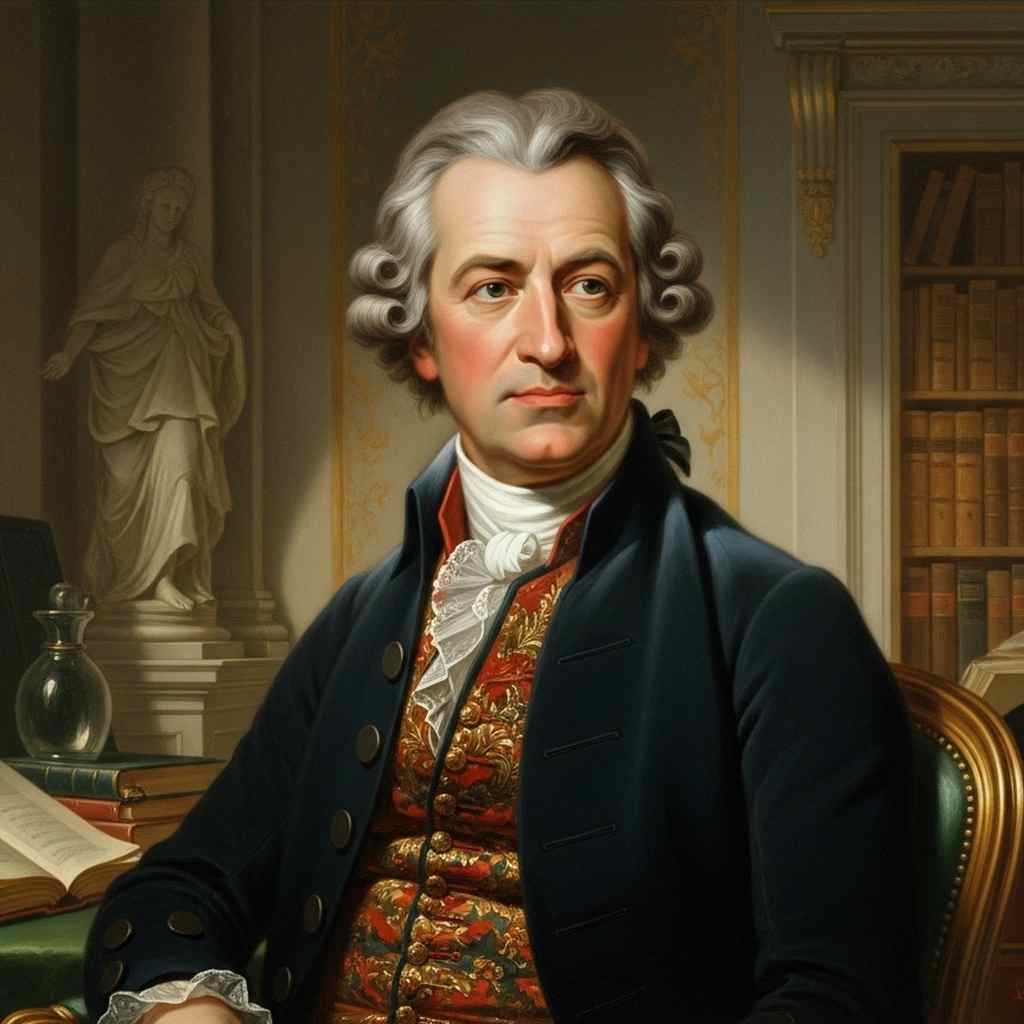Wanderer's Nightsong (German)
Johann Wolfgang von Goethe
1749 to 1832

Wandrers Nachtlied
Über allen Gipfeln
Ist Ruh,
In allen Wipfeln
Spürest du
Kaum einen Hauch;
Die Vögelein schweigen im Walde.
Warte nur, balde
Ruhest du auch.
Johann Wolfgang von Goethe's Wanderer's Nightsong
Johann Wolfgang von Goethe's brief yet powerful poem, "Wandrers Nachtlied" ("Wanderer's Nightsong"), is widely considered a masterpiece of simplicity and profound stillness. Written in 1780, this short piece is exemplary of Goethe’s later, more introspective style, capturing the poet’s reflections on nature, peace, and mortality. Below is a detailed analysis that explores Goethe’s use of language, themes, and structure to evoke a serene, contemplative mood.
Structure and Form
The poem is composed in two short stanzas of four and three lines, respectively. It follows a rhythmic cadence rather than a strict meter, using gentle pauses to guide the reader’s pacing and mirror the stillness Goethe wishes to convey. The rhyme scheme—ABAB and CC—contributes to a sense of closure, with the final two lines offering a contemplative ending that softly lands with a sense of inevitability.
Line-by-Line Analysis
Stanza 1
"Über allen Gipfeln / Ist Ruh," (Above all the hilltops / It is calm.)
The poem begins with an image of tranquility, situating the reader in a vast, elevated space "above all the hilltops." By choosing the word "Gipfeln" (hilltops or peaks), Goethe evokes a sense of isolation from the bustling world below, focusing instead on a lofty, untouched realm. The statement "Ist Ruh" ("It is calm") sets a tone of profound stillness, giving the impression that calmness pervades the natural world in its highest, most distant places.
"In allen Wipfeln / Spürest du" (In all the treetops / You feel)
The scope narrows from the peaks to the treetops, bringing the reader closer to nature’s small details. The shift from “Gipfeln” to “Wipfeln” (treetops) mirrors a gentle descent from the lofty hilltops down toward the earth, symbolizing a move from the distant and grand to the more intimate and close-at-hand. The phrase “Spürest du” ("you feel") invites a personal connection between the reader and the environment, transforming nature’s stillness into a sensory experience.
"Kaum einen Hauch;" (Hardly a breath;)
In this line, the calm becomes nearly imperceptible, with "Kaum" (hardly) and "einen Hauch" (a breath) suggesting a tenuous, fragile tranquility. Goethe's imagery here is almost ethereal; he portrays nature as if it were holding its breath. The line conveys the lightest, faintest motion, or perhaps none at all, immersing the reader in a nearly silent, dreamlike moment.
Stanza 2
"Die Vögelein schweigen im Walde." (The little birds are silent in the forest.)
In this line, Goethe turns from the sensory experience of calm to the specific image of silence within the forest. The diminutive “Vögelein” (little birds) adds a tender touch, softening the scene and highlighting the stillness. The silence of the birds amplifies the absence of sound, deepening the sense of isolation and peace. This line serves as a bridge between the external calm of the natural world and the internal stillness Goethe leads us toward in the final two lines.
"Warte nur, balde / Ruhest du auch." (Just wait, soon / You too will rest.)
The concluding lines bring a gentle, existential revelation. “Warte nur” ("Just wait") suggests patience and acceptance, as if stillness is not merely an aspect of nature but an inevitable state that the reader or wanderer will also experience. “Balde” ("soon") indicates that this peace is not far off; it is something that awaits us all. This reference to “rest” (Ruhen) can be interpreted both literally as sleep and metaphorically as death, suggesting that the calm found in nature is akin to the eternal rest awaiting every living being. Here, Goethe imbues nature with a meditative calm, offering not just solace but a reminder of life's cyclical journey toward quietude.
Themes
1. The Transience and Universality of Peace
The poem conveys a profound sense of universal peace that transcends individual experience. Goethe’s landscape, free of movement and sound, embodies an eternal stillness—a peace that exists independently of human presence yet is deeply connected to the human soul. By focusing on calmness in nature, Goethe suggests that rest is a natural and inevitable state, one that all creatures, and even the human soul, will eventually partake in.
2. Nature and Mortality
Goethe subtly addresses mortality in this poem, embedding it within the peaceful imagery of nature. The final line, “Ruhest du auch” ("You too will rest"), hints at the inevitability of death as a return to nature's calmness. This is not portrayed as something to fear, but rather as an aspect of life that mirrors the quiet stillness of the natural world. In this way, Goethe evokes the Romantic notion of finding unity with nature, suggesting that death is simply another form of rest.
3. Silence and Stillness as a Reflection of Inner Peace
The silence in “Wandrers Nachtlied” is palpable, fostering an inner stillness in the reader. Goethe’s minimalism here mirrors the mental peace that Romanticism often sought in communion with nature. By entering into this silent, resting world, Goethe implies that tranquility in nature is reflective of an internal peace that humanity yearns for, and that by observing the calm around us, we can come to accept this peace within ourselves.
Conclusion
In "Wandrers Nachtlied," Goethe achieves a profound philosophical reflection on peace, mortality, and unity with nature through the simplest of poetic devices. His choice of language, structure, and imagery offers readers a meditative moment, inviting them to experience the calmness of the natural world and to consider their place within it. Goethe's poem thus becomes an invitation to contemplate life and death, to find solace in the quiet of nature, and ultimately, to recognize rest as a universal state to which all life returns.
This short but profound poem is a testament to Goethe’s ability to convey deep existential truths with minimal language, creating a work that resonates with readers across centuries.
This text was generated by AI and is for reference only. Learn more
Want to join the discussion? Reopen or create a unique username to comment. No personal details required!



Comments
No comments yet. Be the first to comment!